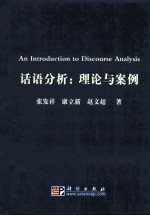
- 作 者:张发祥,康立新,赵文超著
- 出 版 社:北京:科学出版社
- 出版年份:2009
- ISBN:9787030233417
- 标注页数:210 页
- PDF页数:221 页
请阅读订购服务说明与试读!
订购服务说明
1、本站所有的书默认都是PDF格式,该格式图书只能阅读和打印,不能再次编辑。
2、除分上下册或者多册的情况下,一般PDF页数一定要大于标注页数才建议下单购买。【本资源221 ≥210页】
图书下载及付费说明
1、所有的电子图书为PDF格式,支持电脑、手机、平板等各类电子设备阅读;可以任意拷贝文件到不同的阅读设备里进行阅读。
2、电子图书在提交订单后一般半小时内处理完成,最晚48小时内处理完成。(非工作日购买会延迟)
3、所有的电子图书都是原书直接扫描方式制作而成。
Part One Discourse Analysis Theory 3
Chapter 1 An Introduction to Discourse Analysis 3
1.0 Introduction 3
1.1 Definition of discourse 4
1.2 Discourse analysis:its definition and development 7
1.3 "Text","context"and"discourse" 11
1.4 An understanding of DA as a discipline 13
1.5 Conversation analysis and conversational principles 15
1.5.1 Conversation analysis 16
1.5.2 Conversational principles 19
1.6 Eclecticism in discourse analysis 23
1.7 DA and pragmatics 27
Chapter 2 Methodology of Discourse Analysis 29
2.0 Introduction 29
2.1 Methods of doing discourse analysis 29
2.1.1 Structural discourse analysis 30
2.1.2 Socio-cultural discourse analysis 30
2.1.3 Cognitive discourse analysis 31
2.1.4 Critical discourse analysis 31
2.1.5 Integrated discourse analysis 34
2.2 Understanding the methods 34
2.2.1 In terms of focus 35
2.2.2 In terms of aim 36
2.2.3 In terms of technique 38
2.3 Summary 40
Chapter 3 Theoretical Thoughts about Discourse 41
3.0 Introduction 41
3.1 Speech act theory 42
3.2 Cooperative principle theory 46
3.3 Face and politeness principle theory 49
3.4 Relevance theory 53
3.5 The study of stylistic variation and registers 56
3.6 Schema theory 59
3.6.1 The terminology of schema theory 61
3.6.2 Evidence for schemata 63
3.6.3 The origins of schema theory 66
3.7 Post-structuralist theory about discourse 67
3.7.1 Michel Foucault's thoughts about discourse 70
3.7.2 M.M.Bakhtin's dialogic view on discourse 73
3.8 Genre theories 76
3.8.1 The problem of definition 76
3.8.2 Definitions in applied linguistics 78
3.8.3 Systems of genre studies 81
3.9 Summary 93
Chapter 4 Discourse Analysis and Second Language Teaching 95
4.0 Introduction 95
4.1 Application of discourse analysis to grammar teaching 97
4.2 Application of discourse analysis to vocabulary teaching 99
4.3 Application of discourse analysis to text interpretation teaching 101
4.3.1 Top-down and bottom-up text processing 102
4.3.2 Types of text 103
4.3.3 Patterns in text 104
4.4 Application of discourse analysis to conversational interaction teaching 105
4.5 Summary 108
Part Two Cases Analysis 111
Chapter 5 Discourse Types 111
5.0 Introduction 111
5.1 News discourse analysis 111
5.1.1 Vocabulary analysis 112
5.1.2 Word features 117
5.1.3 Syntactical analysis 119
5.2 Public discourse analysis 120
5.2.1 Modal verb analysis 121
5.2.2 Analysis of pronoun 122
5.3 Advertising discourse analysis 125
5.3.1 Lexical features 126
5.3.2 Syntactic features in advertising discourse 144
5.3.3 Rhetorical features in advertising discourse 147
5.4 Diplomatic discourse analysis 152
5.4.1 Forms of achieving vagueness in diplomatic discourse 155
5.4.2 Functions of vagueness in diplomatic discourse 161
5.5 Teacher-student discourse analysis 163
5.5.1 Elements of structure in classroom interaction 164
5.5.2 Classes of acts 167
5.5.3 Classes of moves 168
5.5.4 Classes of exchanges 170
5.6 Humorous discourse analysis 172
5.6.1 Remarkable characteristics of humor 174
5.6.2 Cooperative principle and humor 175
5.6.3 Speech act and humor 178
5.7 Network discourse analysis 179
5.7.1 Reasons for the formation of network discourse 180
5.7.2 Development of network discourse 181
5.7.3 Classifications of network vocabulary 182
5.7.4 Characteristics of network discourse 188
References 197
